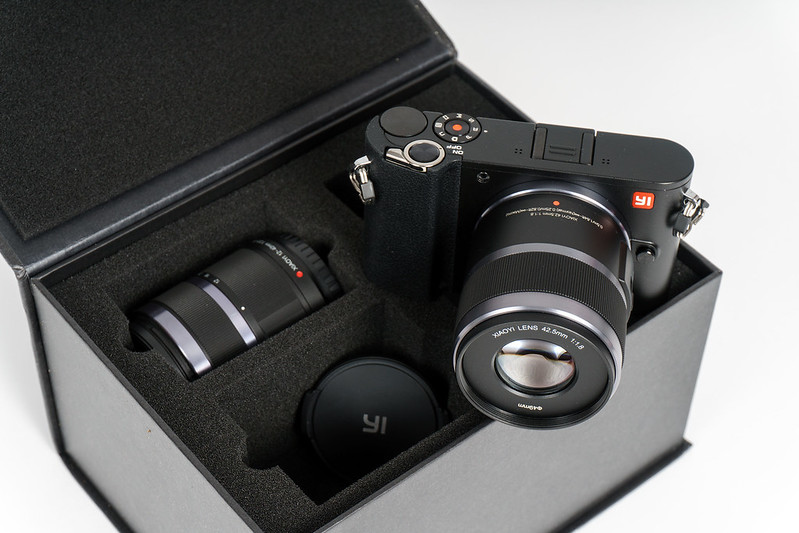One of the few suprises on this year's Photokina was the new and first Chinese mirrorless camera from YI Technology, the M1. Some voices saw it on par even with Sony's A6300. This made me curious and inspired me to take a closer look.
There is a new firmware 1.0.20.-int from 28th November 2016 that adds several features and some fixes. Release Notes:NEW 1. Adding live view interface for video mode, long - press the REC button for 2 seconds to enter. The original one click recording video function is still retained. 2. Adding ISO upper limit setting function of ISO AUTO option. Valid for P / A / S mode. 3. Adding GUI MF function for 42.5mm F1.8 lens. 4. Adding EIS menu for video mode. EIS off by default when recording 4K video. 5. Adding file storage status indication. When the file is written to the memory card, the original location for remaining number will display the corresponding Icon. 6. C-AF video performance improved. Continuous autofocus performance is further enhanced. 7. 4K Video performance improved. 8. Adding German menu.
FIXEDFixed some known bugs, and improved the overall stability of the system.
YI's first Micro Four Thirds (MFT) camera features the Sony IMX269 sensor, capable to deliver 12 bit raw photos with 20 MP and 4K video with 30 fps. You find this sensor also in the Lumix GX8 and the Olympus PEN-F. Beside some Chinese sellers, the YI M1 meanwhile is offered also in the U.S. with prices between $499 (body with 12-40mm f/3.5-5.6 zoom lens) and $699 for the double lens kit including also a 42.5mm f/1.8 macro capable portrait prime lens. You may see the camera for about 2/3 of these prices in some Chinese stores but this is not the international model. I ordered the international double lens kit directly from China, it gets delivered in a nice packaging:
The body weighs 290g (including battery - the manufacturer's site states 280g). The Yi 12-40mm f/3.5-5.6 zoom lens weighs 173g, the 42.5mm f/1.8 macro prime lens weighs 119g, both have no optical image stabilization (although some early "reviews" stated this). The 42.5mm prime has no manual focus ring although it appears like this on product pictures. The camera body is made of plastic but has a comfortable grip and is surprisingly lightweight whereas the 12-40mm zoom is quite huge and heavy compared to other compact zooms like the Lumix G Vario 12-32mm OIS zoom lens (about 70g) or the Olympus M.Zuiko 14-42mm digital ED EZ (93g).
On the rear side you find a 3" touch display and two more buttons. The camera has no electronic view finder (EVF) and no built-in flash (but a hot-shoe for external flash lights, 1/125s sync time). So, on the first glance, these specifications could make it the perfect choice for drone applications as you do not need an EVF or flash there and every gram reducing the payload helps to achieve longer flight times.
The menu system is simple (and limited regarding options) but quite intuitive and delivers an user interface similar to that you may be used from current smartphones. YI provides also an app for smartphones (iOS & Android) that connects to the camera through Bluetooth BLE and WiFi. Currently the app only allows uploading some "Master Guide" templates and firmware updates to the camera and it can download and share JPEG pictures taken with the camera. At the moment it cannot transfer DNG (raw) images or movies recorded with the camera. It also does not provide remote control functions. So there is plenty of room for improvements in future versions...
Using the YI M1 for photography
The short version:
The Sony IMX269 four thirds sensor is the real highlight of this camera.
The longer version:
Taking photos with the YI M1 is pretty easy. You have the typical modes (P, A, S, M and some scene presets), you can choose auto ISO or set ISO manually from 100 (extended) to 25600, base ISO is 200. White balance can be set to AWB (auto) or several manual settings as well. The image format can be set to JPG (S, M, L) or Raw (DNG), but the camera can not save both at the same time. The focus point for auto focus can be choosen from 81 points directly through the touch display. In my tests based on firmware version 1.0.17-int, the focus was pretty quick and reliable even at low light through a focus assist light. The 42.5mm prime lens allows only auto focus at the moment.
Dynamic range and noise
The dynamic range was a positive surprise for me. My last mFT camera before I migrated to Sony APS-C and full frame sensors was the Lumix GH2 (Panasonic sensor) with a very limited dynamic range. Also the signal-to-noise-ratio is pretty well. On pixel level, it is at about the same level compared to the previous Sony 16 MP mFT sensor - but now with resolution increased by 25%. Resolution adjusted you get a slight advantage also on noise ratio. In order to illustrate this, let us take a look at an unprocessed image - just converted from DNG to JPEG - and a processed version:
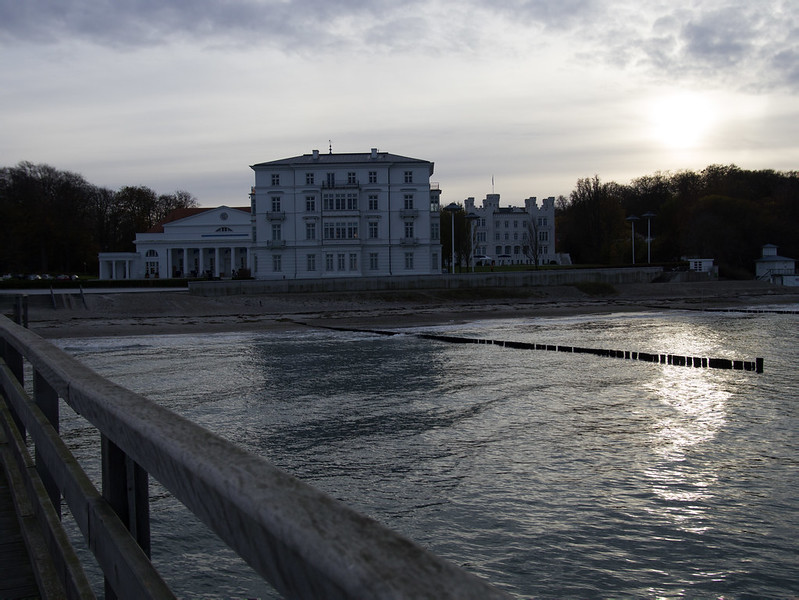
YI M1 with 12-40/3.5-5.6 @ 20mm unprocessed (click on the image for further sizes)
Now with pushed shadows and reduced highlights:

YI M1 with 12-40/3.5-5.6 @ 20mm processed (click on the image for further sizes)
If you take a closer look to the image, you may already see two of the downsides:
- My copy of the 12-40mm zoom lens has a blurry left border, it is obviously decentered
- The first and the last 8 pixels on the left and right borders seem to be duplicated when shooting DNG (not sure if this is an issue of the camera or Adobe Camera Raw that was used to develop the raws)
The noise is pretty well controlled as you can see in this ISO 5000 example:
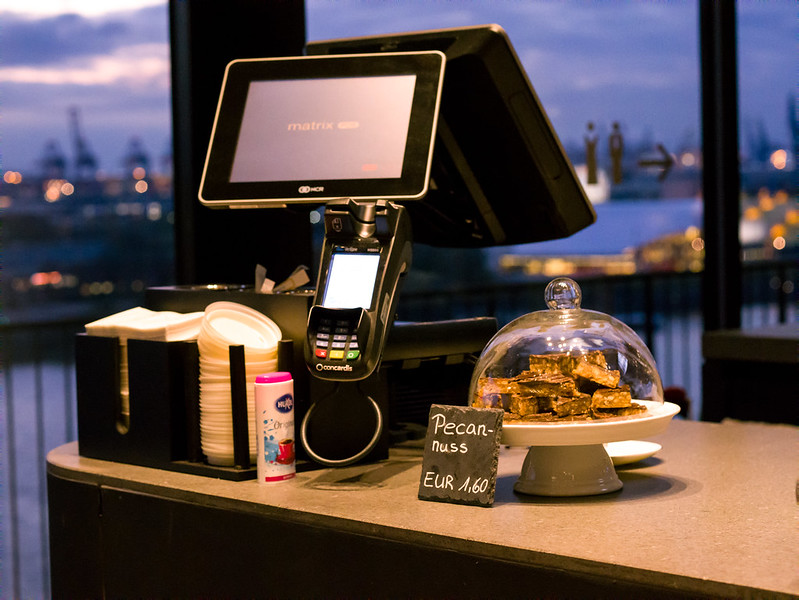
Yi M1 - ISO 5000 (developed from raw) - 42.5/1.8 @ f/3.5
YI M1 @ ISO 640:
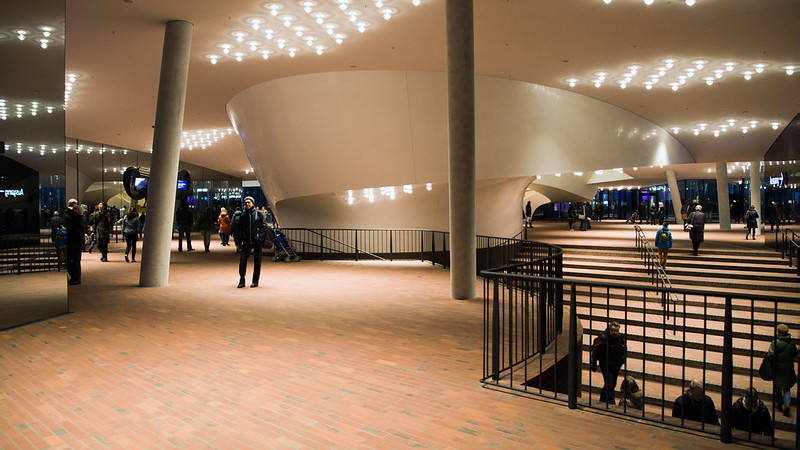
Yi M1 - ISO 640 - Yi 12-40mm @ 12mm
Comparison to Sony A6300 at ISO 640:

Sony A6300 @ ISO 640, Sony 16-50mm @ 16mm
YI M1 @ ISO 320:
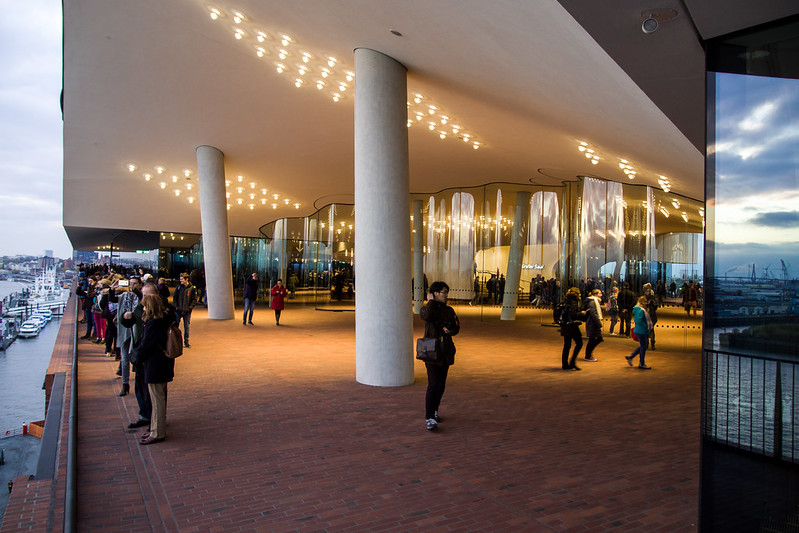
Yi M1 @ ISO 320, Yi 12-40mm @ 12mm
Sony A6300 @ ISO 400:
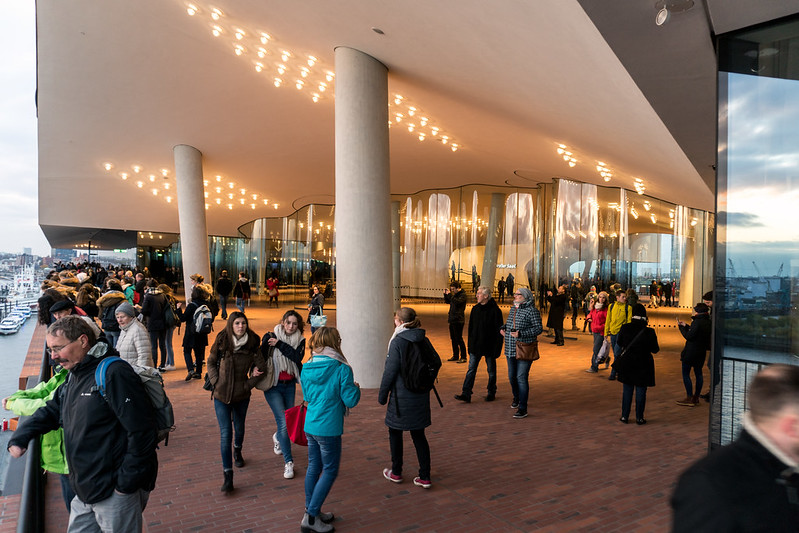
Sony A6300 @ ISO 400, Sony 16-50mm @ 16mm
Yi M1 @ base ISO 200:
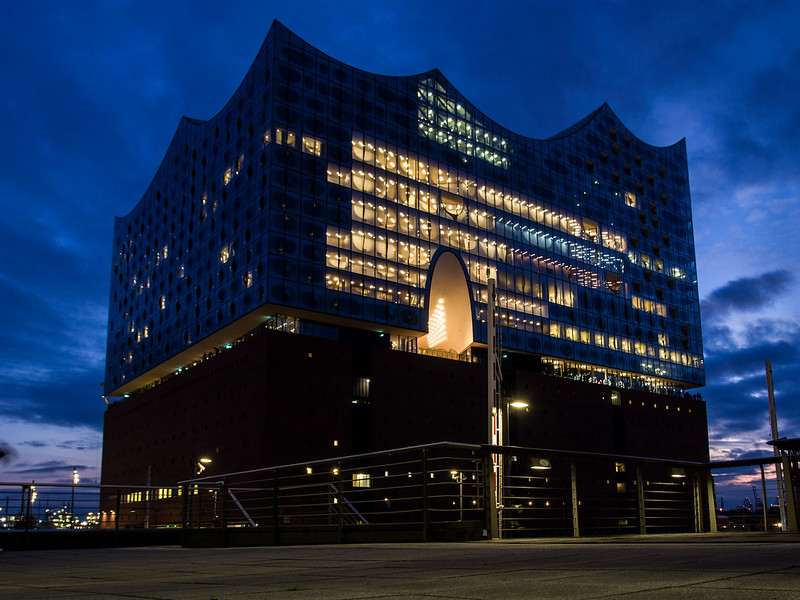
Yi M1 @ base ISO 200, Yi 12-40mm @ 12mm, f/5.6
There is not too much of a difference between the noise on pixel level which is no surprise as both sensors are about the same generation and have similar pixel sizes (3.4 µm for the YI M1, 3.9 µm for the Sony A6300). Resolution adjusted, the A6300 can gather a little advantage.
AWB of the YI M1 sometimes tends to be a bit warm at artifical light but this is not much of an issue if you shoot raw as it can be easily adjusted in post processing.
Bokeh
The 42.5mm f/1.8 lens provides nice options to play with depth of field. It allows you to shoot the main subject in focus with a blurry background:

YI M1 with 42.5mm f/1.8 @ open aperture
This lens is not as compact as the Olympus 45mm f/1.8 but has about the same weight and offers a macro option. The manufacturer specifies it with a magnification of 0.5x but in my tests I could only achieve a magnification of about 0.28x. It is pretty sharp right from open aperture and I like the bokeh but it is not completely free from CA (which can be easily removed in post processing). In contrast to the 12-40mm zoom, which did not convince me, the 42.5 mm macro prime lens looks like a good companion for the YI M1 and an interesting option, if it will be sold seperately for a reasonable price tag. Most of the "Master Guide" templates are designed for that lens.
If you plan to use manual lenses, focussing can be assisted by peaking but the camera currently does not provide a magnified preview to assist you in setting the focus more precisely.
The camera shoots up to 5 fps and offers a time lapse option which is pretty easy to use. It shoots noiseless with a full electronic shutter and produces a 4K movie from the shots automatically but it does not allow to store the shots as single images.
Video
As already said earlier, on the first glance this camera looks like a tempting option for aerial photography and videos on a drone due its lightweight body and the option to record 4K (UHD) at 30 fps. The camera encodes 4K with h.264 (8 bit 4:2:0) at 75 Mbps which is not as much as the A6300 (100 Mbps) but already a bit more than the DJI X5 drone camera (only 60 Mbps).
The manufacturer mentions an electronic image stabilization but early reviews demonstrated a quite irritating warp effect produced by this stabilization. I could not reproduce this "warp" effect - but I also could not see any stabilization applied by my copy at all. It looks like this feature was disabled in firmware 1.0.17-int - and I think, this was a good decision. If you really want to profit from image stabilization, choose a lens that supports it and let the camera just control the setting (e.g. disabling it or restricting it to vertical stabilization during pan shots - currently there is no menu option for this).
If you take a closer look, there are currently far too many limitations:
- The camera allows no manual selection of aperture / shutter time or ISO in video. The only option is a manual correction for over-/under-exposure (+/- 5 EV). Focus mode is forced to C-AF. If you use a manual lens, it will give you at least the option to control focus and aperture manually
- The camera does not provide flat picture profiles (like the Cine gammas or S-Log profiles on Sony cameras) which would give much more room for grading in post processing
- Currently there is no option to remotely start the recording or remotely trigger a photo shot. Even if there were an option through BLE / WiFi, this would interfere with the 2.4 GHz remote controllers used for most drones. The camera does not support 5.8 GHz WiFi.
- In 4K mode, the recording time is limited to only 7 1/2 minutes! YI explains this with the 4GB file size limit but as the memory cards are formatted with exFat, I see no reason to not go beyond that limit. Even if the file size would be limited by the underlying operating system, the camera could continue to write into another file after 4GB are reached for the first file as many other cameras do as well. I tested two subsequent recordings and I could not see any overheating issue - at least not at room temperature and a recording time of 15 minutes which in my opinion would be the minimum requirement in order to be used on a drone.
- The camera has a micro HDMI port but this can only be used for playback. When you record a video and plug in an HDMI cable, the camera immediately stops recording and switches to playback mode. If the camera would be used on a drone, it would have to support also live HDMI output during recording. For me, this is the major downside of this camera at the moment.
Anyway - if you can live with these limitations, the camera provides pretty good results with its automatic settings. The auto exposure works well and the focus is adjusted smoothly. As in 4K mode the camera crops only about 8 MP in 16:9 aspect ratio from the 20 MP 4:3 sensor, you have to take into account an additional crop factor. In 4K video mode, I would estimate the crop factor at about 2.4 - 2.5x which makes it quite difficult to record wide angle videos.
Comparison video with the YI M1 and the Sony A6300
I shot a little comparison video with the Yi M1 and the Sony A6300. As the YI 12-40mm zoom lens did not satisfy my expectations, I used the Lumix G Vario zoom 12-32mm f/3.5-5.6 lens. It weighs only 70g and delivers an amazing image quality for that size and weight. But even at 12mm, the remaining crop has an equivalent angle of view to a 30 mm full frame lens, which is not really a wide angle any more.
So I also tested the Olympus body cap lens 9mm f/8 which is a fisheye lens. It is designed with 5 elements, has manual focus and fixed aperture, but it weighs only 30g which would allow you to record 4K videos with a four thirds sensor with a camera weighing only 320g!!!

Sony A6300 with 16mm f/2.8 pancake (468g) and Yi M1 with Olympus body cap lens 9mm f/8 fisheye (320g)
If you shoot photos with the body cap lens, you may see good center resolution but some blurry borders. They do not play a significant role when using the 4K crop of the YI M1. Also the fisheye distortion is not so extreme in this crop. If you apply further rectification in post processing, the remaining crop is an equivalent to a 24mm lens on full frame and there is still a good resolution in major parts of the screen. You can see that option in the video starting at 01:30.
A better choice for wide angle 4K videos would be the Lumix 7-14mm ultra wide angle lens but this is very heavy and expensive. There will be a manual Laowa 7.5mm ultra wide angle "zero distortion" lens from Venus Optics soon. Propably the best choice for recording really wide angle videos with this sensor in the 4K crop.
On the Sony A6300 the 16-50mm zoom lens was used as well as the 16mm f/2.8 pancake lens. If you record 4K with 24 or 25 fps with this camera, it uses 20 MP from the 24 MP sensor with proper downscaling, so almost a full read-out from the sensor. This provides excellent details and low light capabilities but with the downside that it can not record 30 fps in this mode. If you want to record 4K at 30 fps with the Sony A6300 (as well as with the new A6500), you have accept that it also uses a crop with 1:1 pixels. As the pixel size is not much bigger compared to the pixels of the four thirds sensor, the crop, dynamic range and low light sensivity of the Sony A6300 is not significantly ahead of the Four Thirds sensor anymore.
Conclusion
This camera currently leaves me in a letdown. The hardware looks nice, feels well and has a lot of potential, especially the heart of the camera, the Sony IMX269 Four Thirds sensor. But the firmware as well as the separate smartphone app leaves a lot of room for improvements especially in the video section!
I think many of the current downsides could be adressed and solved by firmware updates, so please YI, add the following features:
- Allow manual settings in video mode
- Allow manual focus also with the 42.5 prime lens through the camera menu / dials
- Add a moveable zoom magnification in preview for precise manual focusing
- Allow longer video recording as the crippled 07:29 in 4K.
- Provide live output on HDMI also during recording
- Add flat picture profiles
- Support remote control at least for video start/stop and single shots
- Support also 5.8 GHz WiFi (and allow to restrict usage to this band)
- Allow to store also the single raw images during time lapse shooting
- Allow control of OIS through camera menu settings
So please set free the potential of the hardware of this camera!
Manufacturer's page: http://www.yitechnology.com/yimirrorless/index/id/8.html





